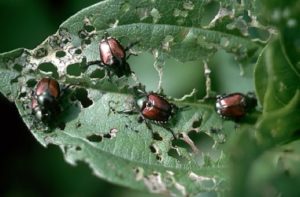 In Atlanta, June sixth is the average, annual arrival date of the Japanese beetle. They will be around until about the end of July or the first of August when the populations will begin to thin. We never know how bad the beetles will be. Many factors such as rainfall and soil temperature affect the grub population and consequently the number of beetles that emerge.
In Atlanta, June sixth is the average, annual arrival date of the Japanese beetle. They will be around until about the end of July or the first of August when the populations will begin to thin. We never know how bad the beetles will be. Many factors such as rainfall and soil temperature affect the grub population and consequently the number of beetles that emerge.
The adult Japanese Beetle, is a pretty metallic green and bronze and about the size of your little finger nail. Japanese beetles have one primary goal in mind which is procreation of their species. On the way to attaining their goal they also focus on taste testing at least one specimen from each of their one hundred favorite varieties of plants. In doing so they can cause extensive damage to the leaves of these susceptible varieties. Their feeding activity causes the leaves to appear lacey. The beetles finish out their lives by laying lots of eggs in the soil. These eggs hatch into one of the many varieties of white grubs you may see in the turf.
Spray applications provide good initial control but after the spray dries, the pesticide must be ingested as a stomach poison to be effective. This requires that the beetle eat some of the treated plant material before it is affected. Some pesticides do cause a negative feeding response in the beetle, slowing their feeding, but they still feed to some degree. Consequently, a reduction of damage is all that is possible.
Do not use the Japanese beetle traps. They do catch beetles, but also draw higher numbers of beetles to your yard. Heavy populations of beetles do not necessarily mean that your yard has a high grub population. Since the adult beetles can fly, they can easily travel from quite a distance away to feed on your shrubs and trees.
A common misconception is that if you treat your turf for grub control that you will not have beetles attacking your plants. These treatments do reduce grub populations IN YOUR TURF and that is it. Again, because of the flight capabilities of the adults, it is highly probable your plants are being attacked by beetles emerging from other yards. There is no 100% control for Japanese beetles and at best, damage to susceptible plants can only be reduced.
« Back to Glossary Index